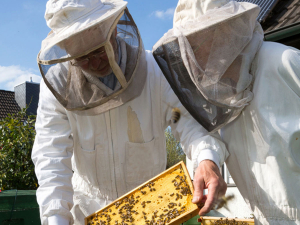Planting to feed the bees
The Ministry for Primary Industries (MPI) have released a handbook offering guidance on how to plant strategically to feed bees.
 Supermarkets have cut the price paid to suppliers, but haven’t cut the price on the shop shelf, claims Lorimer.
Supermarkets have cut the price paid to suppliers, but haven’t cut the price on the shop shelf, claims Lorimer.
Supermarkets have put the squeeze on beekeepers who supply them, claims Jane Lorimer, NZ Beekeeping president.
They have cut the price paid to suppliers, but haven’t cut the price on the shop shelf. So consumers still see honey as really expensive.
“We have cut back but the supermarkets are making more money out of their product. We definitely had the squeeze put on us ‘drop your price or you are out’.”
Head of corporate affairs, Foodstuffs NZ, Antoinette Laird, told Rural News there is currently an over-supply of non-manuka honey varieties in the market which has softened retail prices.
“This is great for shoppers who benefit as honey prices drop - but we do recognise this common supply and demand outcome challenges the supplier community,” she says.
“Last year 500g of Pams Clover Creamed Honey retailed at $12.49 and today costs $6.99 at New World, while Airborne Honey Liquid 500g, which retailed $12.19 in 2019 is now on-shelf at $7.99 – making New Zealand produced honey a very affordable option for more of our customers.”
A Countdown supermarket spokesperson told Rural News the price of honey spiked a couple of years ago and it’s now coming back down due to the changed manuka regulations and an over-supply of clover and blended honeys.
“Our honey prices have dropped about 15% in the last year. Previously the high honey prices meant it was becoming too expensive for customers to choose honey as a spread or ingredient, but we’re starting to see honey sales pick up again now that it’s more affordable for customers.”
A Taranaki farmer and livestock agent who illegally swapped NAIT tags from cows infected with a bovine disease in an attempt to sell the cows has been fined $15,000.
Bill and Michelle Burgess had an eye-opening realisation when they produced the same with fewer cows.
It was love that first led Leah Prankerd to dairying. Decades later, it's her passion for the industry keeping her there, supporting, and inspiring farmers across the region.
Rangitikei Rivers Catchment Collective (RRCC) chairperson Roger Dalrymple says farmers in his region are taking a national lead in water quality awareness and monitoring.
One young couple is proving farm ownership is still within reach for young Kiwis.
Greenlea Premier Meats managing director Anthony (Tony) Egan says receiving the officer of the New Zealand Order of Merit (ONZM) honour has been humbling.